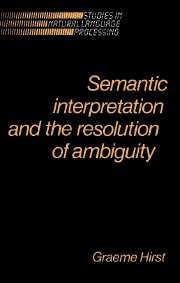Summary
Introduction
In the description of Absity in chapter 3, I made the unrealistic assumption that each word and pseudo-word corresponds to the same unique semantic object whenever and wherever it occurs; that is, I assumed there to be no lexical ambiguity and no case flag ambiguity. In this chapter, I will remove this assumption. The goal will be to develop a method for disambiguating words and case flags within the framework of Absity, finding the correct semantic object for an ambiguous lexeme.
Since Absity is “Montague-inspired” (sections 2.2.2 and3.2), the obvious thing to do first is see how Montague handled lexical ambiguity in his PTQ formalism (Montague 1973) (see section 2.2.2). It turns out, however, that Montague had nothing to say on the matter. His PTQ fragment assumes, as we did in chapter 3 but no longer wish to, that there is a unique semantic object for each lexeme. Nor does Montague explicitly use case flags. The verbs of the fragment are all treated as oneplace or two-place functions, and syntactic position in the sentence distinguishes the arguments. Nevertheless, there is an easy opening in the formalism where we may deal with lexical ambiguity: except for a few special words, Montague's formalism does not specify where the translation of a word comes from; rather, there is assumed to be a function g that maps a word a to its translation, or semantic object, g(α),and as long as g(α) (which is usually denoted α') is of the correct semantic type, it doesn't really matter how gdoes its mapping. This means that if we can “hide” disambiguation inside g, we need make no change to the formalism itself to deal with ambiguity in PTQ.
- Type
- Chapter
- Information
- Semantic Interpretation and the Resolution of Ambiguity , pp. 96 - 128Publisher: Cambridge University PressPrint publication year: 1987



